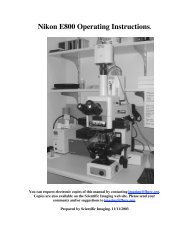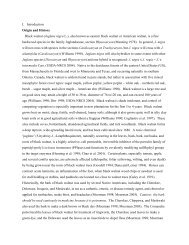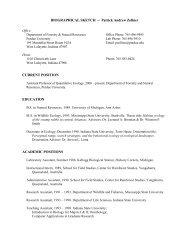Raising Game Birds - License Requirements - Purdue Agriculture ...
Raising Game Birds - License Requirements - Purdue Agriculture ...
Raising Game Birds - License Requirements - Purdue Agriculture ...
Create successful ePaper yourself
Turn your PDF publications into a flip-book with our unique Google optimized e-Paper software.
<strong>Raising</strong> <strong>Game</strong> <strong>Birds</strong> - <strong>License</strong> <strong>Requirements</strong><br />
Synopsis by Dr. Natalie Carroll <strong>Purdue</strong> University Department of Youth Development and Agricultural Education<br />
If you acquire a live game bird (ring-necked pheasant or bobwhite quail, including their subspecies and color<br />
phases) or purchase a live game bird, you must apply for a game breeder’s license with the Indiana Department of<br />
Natural Resources (DNR) within five (5) days. A game bird possessed under a game breeder’s license issued by<br />
the DNR may be released or sold for food purposes, breeding purposes, or for release. A person who buys a game<br />
bird from an out-of-state breeder (licensed game breeders, only) must be able to show legal proof of out-of-state<br />
origin for all game birds possessed, including both a receipt and health certificate.<br />
The DNR may issue to a resident of Indiana, upon the payment of a fee of fifteen dollars ($15), a license to<br />
propagate in captivity; and possess, buy, or sell for this purpose only; game birds, game mammals, or furbearing<br />
mammals protected by Indiana law. The license must be renewed annually. There is no minimum age<br />
requirement for an application for a game breeder's license, so although the application asks for a driver’s license<br />
number, it is not required. The license holder is the one responsible for the record-keeping and other requirements<br />
of the law, however, so it may be best to have the parents sign the application form as well. Note: you may not<br />
raise wild turkeys or ruffed grouse<br />
Notes:<br />
• Each game bird must be lawfully acquired. A receipted invoice, bill of lading, or other satisfactory<br />
evidence of lawful acquisition (copy of a valid game breeder license or valid dated receipt that establishes<br />
lawful acquisition or ownership) shall be presented for inspection upon the request of a conservation<br />
officer and must accompany any transportation of game birds.<br />
• <strong>Birds</strong> (and eggs) imported into Indiana require a certificate of veterinary inspection (health certificate)<br />
from an accredited veterinarian in the state of origin before the game bird is shipped into Indiana.<br />
• Each cage or enclosure will be inspected by a conservation officer before a license may be issued.<br />
• The game bird must be confined in a cage or other enclosure that makes escape of the game bird unlikely<br />
and prevents the entrance of free-roaming game birds of the same species.<br />
• Each game bird shall be handled, housed, and transported in a sanitary and humane manner.<br />
• Bobwhite quail and ring-necked pheasants may be released into the wild on land in which you have<br />
permission.<br />
• A known diseased game bird may not be released and shall not be sold.<br />
• A license holder is required to keep accurate records of purchases, sales, names and addresses (buyer and<br />
seller), and number and species of game birds sold for at least two (2) years after the transaction.<br />
• The license holder shall provide an annual report to the division by February 15. The annual report shall<br />
include, for each species possessed, the following information: number bought, number sold, number<br />
born, number traded, number gifted, number released, number of deaths, and number on hand<br />
• A conservation officer may enter the premises of the license holder at all reasonable hours to inspect<br />
those premises and any records relative to the license.<br />
See the full statute for additional information and regulations.<br />
Contact the DNR to request an application or for more information:<br />
Telephone: (317) 233-6527 or (317) 232-4102<br />
E-mail: lpetercheff@ dnr.in.gov<br />
1
IC 14-22-20 Chapter 20. Breeder's <strong>License</strong><br />
INDIANA GAME BREEDER LICENSE LAWS<br />
IC 14-22-20-1<br />
Issuance; fee<br />
Sec. 1. The department may, under rules adopted under IC 4-22-2, issue to a resident of Indiana, upon the<br />
payment of a fee of fifteen dollars ($15), a license to:<br />
(1) propagate in captivity; and<br />
(2) possess, buy, or sell for this purpose only;<br />
game birds, game mammals, or furbearing mammals protected by Indiana law.<br />
As added by P.L.1-1995, SEC.15.<br />
IC 14-22-20-2<br />
Sales authorized; application<br />
Sec. 2. A license issued under this chapter authorizes the sale of nonmigratory game birds, game mammals, or<br />
furbearing mammals for breeding purposes or for release and nonmigratory game birds for food purposes. A<br />
person who:<br />
(1) acquires a game bird, game mammal, or furbearing mammal alive, legally in open season; or<br />
(2) purchases the bird or mammal from a licensed game breeder;<br />
may apply for a breeder's license within five (5) days after acquiring the animal from the licensed game breeder or<br />
within five (5) days after the last day of the open season for the animal. Otherwise, the animal shall be released.<br />
As added by P.L.1-1995, SEC.15.<br />
IC 14-22-20-3<br />
Importation of out-of-state animals<br />
Sec. 3. An animal raised domestically by an out-of-state breeder may be imported into Indiana and sold for<br />
food purposes. A purchaser of such an animal raised domestically by an out-of-state breeder must be able to show<br />
legal proof of out-of-state origin for all animals possessed.<br />
As added by P.L.1-1995, SEC.15.<br />
IC 14-22-20-4<br />
Exemption for certain animals<br />
Sec. 4. (a) This section applies to the following:<br />
(1) Marten.<br />
(2) Nutria.<br />
(3) Mink.<br />
(4) Chinchilla.<br />
(5) Domesticated rabbits, except cottontail.<br />
(6) Swamp rabbits.<br />
(b) The:<br />
(1) breeding, raising, and producing in captivity; and<br />
(2) marketing;<br />
of an animal listed in subsection (a) is considered an agricultural pursuit. All animals so raised in captivity are<br />
considered domestic animals so that a game breeding license is not required to possess such an animal.<br />
(c) A person engaged in the breeding, raising, and producing in captivity and marketing of the furbearing<br />
mammals listed in subsection (a) shall, upon request, do the following:<br />
(1) Register with the department.<br />
(2) Make annual reports concerning the number of animals held and sold. These reports are confidential.<br />
As added by P.L.1-1995, SEC.15.<br />
312 IAC 9-10-4 <strong>Game</strong> breeder licenses<br />
Authority: IC 14-22-2-6; IC 14-22-20<br />
2
Affected: IC 14-22<br />
Sec. 4. (a) An application for a license as a game breeder of one (1) or more of the following species of wild<br />
animals (common names are included for public convenience, but the scientific names control) shall be made on a<br />
departmental form:<br />
(1) Ring-necked pheasant (Phasianus colchicus)<br />
(2) Bobwhite quail (Colinus virginianus)<br />
(3) White-tailed deer (Odocoileus virginianus)<br />
(4) Eastern cottontail rabbit (Sylvilagus floridanus).<br />
(5) Gray squirrel (Sciurus carolinensis)<br />
(6) Fox squirrel (Sciurus niger)<br />
(7) Southern flying squirrel (Glaucomys volans)<br />
(8) Beaver (Castor canadensis)<br />
(9) Coyote (Canis latrans)<br />
(10) Gray fox (Urocyon cinereoargenteus)<br />
(11) Red fox (Vulpes vulpes)<br />
(12) Mink (Mustela vison)<br />
(13) Muskrat (Ondatra zibethicus)<br />
(14) Opossum (Didelphis marsupialis)<br />
(15) Raccoon (Procyon lotor)<br />
(16) Striped skunk (Mephitis mephitis)<br />
(17) Long-tailed weasel (Mustela frenata)<br />
(18) Least weasel (Mustela nivalis or Mustela rixosa)<br />
(b) An application for a permit under this section must be made within five (5) days after the acquisition of an<br />
animal within Indiana or within five (5) days after the importation of an animal into Indiana. Each cage or<br />
enclosure will be inspected by a conservation officer before a license may be issued.<br />
(c) A license holder may add a species to a game breeder license other than those identified in the application<br />
upon an inspection by a conservation officer and approval by the division of fish and wildlife. A conservation<br />
officer must be notified within five (5) days of acquisition of the new species.<br />
(d) Each animal possessed under this section must be lawfully acquired. A receipted invoice, bill of lading, or<br />
other satisfactory evidence of lawful acquisition shall be presented for inspection upon the request of a<br />
conservation officer. <strong>Game</strong> or furbearing mammals or game birds, other than wild turkeys, lawfully taken in<br />
season may be retained alive after the close of the season. Any person wishing to import any live animal under<br />
this license, or the eggs of birds covered under this license, must secure a certificate of veterinary inspection from<br />
an accredited veterinarian in the state of origin before the animal is shipped into Indiana. Documentation in the<br />
form of a copy of a valid game breeder license or valid dated receipt that establishes lawful acquisition or<br />
ownership must accompany any transportation of wild animals.<br />
(e) A wild animal must be confined in a cage or other enclosure that makes escape of the animal unlikely and<br />
prevents the entrance of a free-roaming animal of the same species. The cage or enclosure shall be large enough to<br />
provide the wild animal with ample space for exercise and to avoid overcrowding. All chain link or welded wire<br />
edges shall be smoothly secured to prevent injury to the animals and be kept properly repaired. Night quarters,<br />
holding pens, and nesting boxes may not be used as primary housing. Fresh water, rainproof dens, nest boxes,<br />
windbreaks, shelters, shade, and bedding shall be provided as required for the comfort of the particular species of<br />
animal. Each animal shall be handled, housed, and transported in a sanitary and humane manner. An enclosure<br />
must be provided with sufficient drainage to prevent standing water from accumulating. The cages or other<br />
enclosures must be made available upon request for inspection by a conservation officer.<br />
3
(f) No wild animals may be released except for bobwhite quail and ring-necked pheasants. Known diseased<br />
bobwhite quail and ring-necked pheasants may not be released. A license holder must report the escape of any<br />
white-tailed deer to a conservation officer within twenty-four (24) hours.<br />
(g) A known diseased wild animal possessed under this section shall not be sold.<br />
(h) A license holder must comply with all applicable state, local or other federal laws.<br />
(i) A license holder shall do the following:<br />
(1) Record all transactions by which a wild animal is sold, traded, loaned, bartered or given to another<br />
person on a departmental form or computerized record.<br />
(2) Keep a copy of the transaction record on the premises of the game breeder for at least two (2) years<br />
after the transaction and a copy must be provided to a conservation officer upon request.<br />
(3) Issue a valid, dated receipt for all animals sold, traded, bartered or gifted and include the following<br />
information:<br />
(A) <strong>Game</strong> breeder license number.<br />
(B) Buyer and seller name and address.<br />
(C) Number of animals sold.<br />
(D) Species of animal sold.<br />
(j) The license holder shall provide an annual report to the division by February 15. The annual report shall<br />
include for each species possessed under this license the following information:<br />
(1) number bought.<br />
(2) number sold.<br />
(3) number born.<br />
(4) number traded.<br />
(5) number gifted.<br />
(6) number of deaths.<br />
(k) A conservation officer may enter the premises of the license holder at all reasonable hours to inspect those<br />
premises and any records relative to the license. The conservation officer shall immediately notify the license<br />
holder if the inspection reveals that the wild animals are being kept under unsanitary or inhumane conditions. The<br />
conservation officer may make a second inspection after ten (10) days, and the license may be suspended or<br />
revoked under IC 4-21.5 and the wild animals may be confiscated if the license holder fails to comply with a<br />
provision of the license.<br />
(l) A license may be suspended, denied, or revoked under IC 4-21.5 if the license holder fails to comply with<br />
any of the following:<br />
(1) A provision of a license issued under this section.<br />
(2) IC 14-22-20.<br />
(3) All applicable state, local or other federal laws.<br />
(Natural Resources Commission; 312 IAC 9-10-4; filed May 12, 1997, 10:00 a.m.: 20 IR 2728; readopted filed<br />
Jul 28, 2003, 12:00 p.m.: 27 IR 286; filed Jan 26, 2004, 10:45 a.m.: 27 IR 1789)<br />
4








